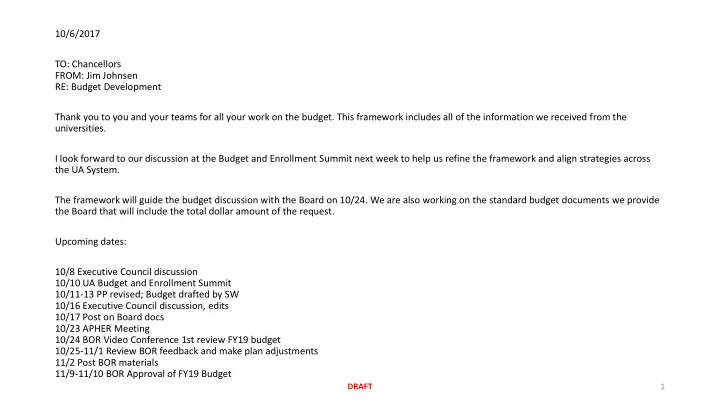

10/6/2017 TO: Chancellors FROM: Jim Johnsen RE: Budget Development Thank you to you and your teams for all your work on the budget. This framework includes all of the information we received from the universities. I look forward to our discussion at the Budget and Enrollment Summit next week to help us refine the framework and align strategies across the UA System. The framework will guide the budget discussion with the Board on 10/24. We are also working on the standard budget documents we provide the Board that will include the total dollar amount of the request. Upcoming dates: 10/8 Executive Council discussion 10/10 UA Budget and Enrollment Summit 10/11-13 PP revised; Budget drafted by SW 10/16 Executive Council discussion, edits 10/17 Post on Board docs 10/23 APHER Meeting 10/24 BOR Video Conference 1st review FY19 budget 10/25-11/1 Review BOR feedback and make plan adjustments 11/2 Post BOR materials 11/9-11/10 BOR Approval of FY19 Budget DRAFT 1
The University of Alaska is Creating a Culture of Education in Alaska by increasing: * the degree attainment of our students * * the number of skilled Alaskans for our workforce * * our world class research * * our contribution to Alaska’s economic development * * the university’s cost effectiveness * DRAFT 2
A Culture of Education in Alaska Alaska is a land of great wealth in terms of its natural resources and environment, global location, diverse cultures, adventurous people, and opportunity to create a sustainable future for generations to come. Our state faces very serious challenges, including a vast geography and a small population, low educational attainment, health disparities, critical workforce gaps, narrow economic base, and high costs in such areas as health care, facilities, energy, and telecommunications. There is no single organization in Alaska better poised — with the mission, the assets, and the commitment —to solve Alaska’s problems than the University of Alaska. Its top quality courses and programs, high powered research into issues relevant to Alaska and the world, and critical role of public and community service — through its campuses and on-line programs available all across the state — make the University a prime investment in the capabilities and the ideas that will propel Alaska forward. DRAFT 3
Overview 1. System Level Goals, Measures and Strategies 2. System Level and University Goals 3. UA 2025: Annual System Level Goals by University 4. System Level Communication and Advocacy 5. UAA Goals and Strategies 6. UAF Goals and Strategies 7. UAS Goals and Strategies DRAFT 4
System Level Goals, Measures and Strategies DRAFT 5
UA 2025 Goals and Measures (Context) 1. Increase degree attainment A. Increase enrollment from 29,171 to 45,000 (55%)…6.3% of AK state population, as in 1975 B. Increase completions from 4,600 to 10,400 (126%)…represents an increase in enrollment and in completion rate up to national average 2. Provide Alaska’s skilled workforce A. Increase percentage of educators hired from 30% to 90%...represents ambitious commitment to meet needs of Alaska’s schools an d kids B. Increase number of graduates from health programs from 765 to 1,530 (100%)…responds to projected growth in health care workforce 3. Grow our world class research A. Continue leading the world in Arctic research…currently #1 in terms of publications and citations in academic journals B. Increase research expenditures from $159 million to $235 million (5% per year)… reflects capacity for additional research spending 4. Contribute to Alaska’s economic development A. Increase the number of invention disclosures from 17 to 34 (100%)…reflects heightened commitment and support B. Increase STEM graduates from 1,640 to 2,460 (50%)…responds to projected growth in STEM jobs in Alaska 5. Operate more cost effectively A. Decrease total cost of education (indirect and direct) per completer from $130k to $75k* (COL adjusted peer average) …represents the average for our peers (* we are reviewing other options as IPEDS data will not be available until spring 2018) B. Decrease annual student FTE per completion from 4.4 to 3.7 (Peer comparison values are for FY16, as FY17 information for other institutions will not be made available by IPEDS until fall 2018) DRAFT 6
UA 2025 System Level Goals and Measures 2017 2018 2019 2020 2021 2022 2023 2024 2025 (baseline) 1. Increase degree attainment A. Increasing enrollment by 55% 29,171 29,171 31,000 33,000 35,000 37,500 40,000 42,500 45,000 B. Increasing completions by 126% 4,600 4,800 5,200 5,800 6,600 7,500 8,400 9,400 10,400 2. Provide Alaska’s skilled workforce A. Increase % of educators hired from 30% to 90% 30% 35% 40% 45% 50% 60% 70% 80% 90% B. Double number of health program completers 765 834 910 992 1,082 1,180 1,287 1,403 1,530 3. Grow our world class research A. Continue leading the world in Arctic research 1 1 1 1 1 1 1 1 1 B. Increase research expenditures to $235 million $159m $167m $175m $184m $193m $203m $213m $224m $235m 4. Contribute to Alaska’s economic development A. Increase the number of invention disclosures from 17 19 21 23 25 27 29 31 34 17 to 34 B. Increase STEM graduates from 1,640 to 2,460 1,640 1,720 1,810 1,905 2,005 2,110 2,221 2,337 2,460 5. Operate more cost effectively A. Decrease total cost of education (indirect and direct) per $130k $128k $125k $122k $115k $105k $95k $85k $75.4k completer from $130k to $75.4k B. Decrease annual student FTE per completion from 4.4 to 4.2 4.3 4.2 4.2 4.1 4.0 3.9 3.8 3.7 3.7 DRAFT 7
For each goal, our guiding questions: • Importance Why is the goal important? • Partnerships With what groups should we partner to achieve the goal? • Finance What are the finance strategies needed to achieve the goal? • Policy What policies, regulations, and processes should be revised or added? • Accountable/Governance Who is accountable for overall success? Who is responsible for specific strategy? Who is consulted? Who is informed? What is the role of governance organizations? • Resources What resources are needed, to include funding, people, facilities, or technology? DRAFT 8
Recommend
More recommend